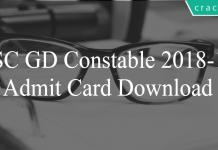SSC Stenographer General Awareness Questions PDF
SSC Stenographer Constable General Awareness Question and Answers download PDF based on previous year question paper of SSC Stenographer exam. 20 Very important General Awareness questions for Stenographer Constable.
SSC STENOGRAPHER GENERAL AWARENESS QUESTIONS PDF
GET 10 SSC STENOGRAPHER MOCKS FOR JUST RS. 117
Download Very Important SSC Stenographer Questions PDF Topic Wise
Question 1: General Dyer, who was responsible for Jallianwalan Bagh massacre, was shot dead by?
a) Hasrat Mohini
b) Vir Savarkar
c) Udham Singh
d) Jatin Das
Question 2: Who is the first law officer of the country?
a) Chief Justice of India
b) Attorney General
c) Law Minister
d) Solicitor General
Question 3: The Comptroller and Auditor General is closely connected with which of the following Committees of Parliament?
a) The Estimates Committee
b) The Committee on Public Undertakings
c) The Public Accounts Committee
d) All of these
Question 4: The Comptroller and Auditor-General of India submits his report relating to the accounts of the Union to the ______________ .
a) Finance Minister
b) Prime Minister
c) President
d) Chief Justice of the Supreme Court
Question 5: Who is generally considered to be the father of the Indian Renaissance?
a) Rabindranath Tagore
b) Raja Rammohan Roy
c) Mahatma Phule
d) M.G. Ranade
GET ALL SSC/RRB/BANKING @ JUST RS. 199
Question 6: Name the British General who was responsible for the Jallianwalla Bagh massacre.
a) Hastings
b) Cornwallis
c) Dyer
d) Dalhousie
Question 7: Biological names are generally derived from which language?
a) French
b) Latin
c) Mexican
d) German
FREE SSC MATERIAL – 18000 FREE QUESTIONS
Question 8: Comptroller and Auditor General of India is appointed for how many years?
a) 2
b) 4
c) 6
d) 5
Question 9: Convex mirror is generally used in _____.
a) solar cookers
b) opthalmoscope
c) reflector for head light
d) rear view mirror
Question 10: Who has been appointed as the Secretary General of the United Nations in January, 2017?
a) Ban Ki-Moon
b) Kofi Annan
c) Boutros-Boutros Ghali
d) Antonio Guterres
Question 11: Who gave the ‘General Equilibrium Theory’?
a) J. M. Keynes
b) Leon Walras
c) David Ricardo
d) Adam Smith
Instructions
In the following passage some of the words have been left out. Read the passage carefully and choose the correct answer to each question out of the four alternatives and fill in the blanks.
The Dalmatian of the sole surviving (semi-) speaker, Tuone Udaina, was surveyed in the late 1870s and again towards the end of his life in the late 1890s. These fairly extensive records curiously suggest that a systematic 189 change took place in those two decades such that by the 1980s the distinction between present and imperfect indicative had largely been neutralized (a development unique among Romance languages) in favour of the imperfect tense forms. I argue that the data are authentic and that the change, whether in occurred just in Udaina’s head or was already underway in the last years of Dalmatian as a spoken language, is purely ‘internal’ and not 190 by contact with other languages. I explore its internal mechanisms and show that what is involved is a kind of analogical form-meaning levelling whose signatium is an ‘empty’ element of 191 structure. Reinforcement of this essentially ‘nonsensical’ 192 of paradigmatic structure constitutes further evidence for my general view tat intrapadigmatic coherence may be no less important than extra morphological transparency. It also suggests that such a development can as easily 193 in a dying language as anywhere else.
SSC Stenographer Previous Papers
Question 12:
a) occur
b) defy
c) ensured
d) occurrence
Question 13:
a) hazard
b) aberration
c) fluke
d) oddity
Question 14:
a) vulnerable
b) paradigmatic
c) indifferent
d) unsuitable
Question 15:
a) deters
b) motirated
c) encourages
d) restores
SSC STENOGRAPHER PREVIOUS PAPERS
Question 16:
a) morphological
b) misleading
c) nonsensical
d) common
Question 17: A sentence is given with blanks to be filled in with appropriate words. Four alternatives are suggested. Choose the correct alternative out of the four. Mr. Naimi, the chief secretary, was unceremoniously_____after party’s______ defeat in general elections.
a) exiled, predictable
b) ousted, disastrous
c) recommended, unexpected
d) honoured, stupendous
Instructions
A passage is given with five questions following it. Read the passage carefully and select the best answer to each question out of the given four alternatives.
Corruption is not a uniquely Indian phenomenon. It is witnessed all over the world in developing as well as developed countries. It has spread its tentacles in every sphere of life, namely business administration, politics, officialdom, and services. In fact, there is hardly any sector which can be characterised for not being infected with the vices of corruption. Corruption is rampant in every segment and every section of society, barring the social status attached to it. Nobody can be considered free from corruption from a high ranking officer.
To root out the evil of corruption from society, we need to make a comprehensive code of conduct for politicians, legislatures, bureaucrats, and such code should be strictly enforced. Judiciary should be given more independence and initiatives on issues related to corruption. Special courts should be set-up to take up such issues and speedy trial is to be promoted. Law and order machinery should be allowed to work without political interference. NGOs and media should come forward to create awareness against corruption in society and educate people to combat this evil. Only then we would be able to save our system from being collapsed.
Question 18: What kind of status is being barred by the corruption?
a) social
b) economic
c) mental
d) physical
Instructions
A passage is given with five questions following it. Read the passage carefully and select the best answer to each question out of the given four alternatives.
Superstitions are a universal phenomena having their own peculiar place in the cultural ethos and milieu of a people. They epitomize man’s fear of the unknown, fear of evil, blind faith in omens and portents. Superstitions are inter-woven with myth, legend, unnatural phenomena and disaster, customs and traditions, and are mainly the outcome of ignorance. They are unreasoned and irrational beliefs that gradually become matters of faith. When certain things and happenings are rationally inexplicable people tend to assign mysterious and supernatural reasons for their operation. Thus a natural disaster is explained in terms of God’s wrath and the failure of one’s project is assigned to the black cat which crossed the path just as one set out on the errand. The primitive human beings were mainly governed by superstitions. Superstitions were widespread before the dawn of civilization when science had not advanced. Thus, ignorance of the primitive people and the resultant growth of superstitions were the direct outcome of the lack of scientific advancement. Unenlightened people always tend to be superstitious. The belief in the sanctity of time and old traditions of the ancestors bind the people into knots of superstitious thought.
Besides, the unscrupulous priests and religious officials exercise a dominating, unhealthy effect upon the people believing in religious orthodoxy. They encourage superstitions for their own ulterior motives. Superstitions are not only universally prevalent but even have strikingly common features whether believed in India or in as far off a place as Canada. There are some common superstitions which are shared by people all over the world. Beliefs in spirits, ghosts and witches and reincarnation are quite common among all the peoples of the world. Belief in witches still prevails in India, France, Scotland, England and many other countries. In countries of the East, especially in India, belief in ghosts and spirits still exists. The cries of certain birds like owls and ravens and the howl of cats are regarded with superstition as portents of evil throughout the world. Then there is a very common belief that the sighting of comets portends the death of kings or great men or some unforeseen catastrophe. Shakespeare refers to such a superstition in his Julius Ceaser, Halley’s Comet in the twentieth century evoked a similar response in many a mind.
Question 19: What can only be the effective counter of superstition?
a) belief in the sanctity of time
b) awareness through plays like Julius Ceaser by Shakespeare
c) explaining the theory of reincarnation
d) a broad light of scientific discovery
Instructions
A passage is given with five questions following it. Read the passage carefully and select the best answer to each question out of the given four alternatives.
The size of the workforce in Brazil, the number of kids at home and parents to sustain will obviously have a great impact on the extent of poverty in Brazilian households. In fact, the demographic transition that has been ongoing in Brazil for the past few decades has helped a lot in reducing poverty. Less children were born in poorer families and that’s less children that ended up involved in street violence, drugs, gangs and so on. More parents were then able to push their kids to go to school and get an education. Of course, the situation is still pretty bad in Brazilian slums (favelas), but it’s estimated that the demographic transition had an impact equivalent to + 0.5% in GDP
growth, which is not bad at all considering that the average GDP growth (per capita) was about 3% per year at the time. And since this transition happened over 30 years, its impact on the economy is equal to around 15% of growth in GDP (over three decades). Overall, the change in the family structure and in Brazilians’ lifestyle has had a much greater impact on reducing poverty than the speed of the demographic transition itself. On the other hand, the transition did have an influence on wages (e.g. supply of labor) and interest rates in a way that worsened poverty in Brazil (less overall income).
Question 20: What has impacted on reducing poverty in Brazil than the speed of the demographic transition itself?
a) Brazilians lifestyle
b) change in family structure
c) awareness among citizens
d) Both Brazilians lifestyle and change in family structure
FREE MOCK TEST FOR SSC STENOGRAPHER
Answers & Solutions:
1) Answer (C)
2) Answer (B)
3) Answer (C)
4) Answer (C)
5) Answer (B)
6) Answer (C)
7) Answer (B)
8) Answer (C)
9) Answer (D)
10) Answer (D)
11) Answer (B)
12) Answer (A)
13) Answer (D)
14) Answer (B)
15) Answer (B)
16) Answer (A)
17) Answer (B)
18) Answer (A)
19) Answer (D)
20) Answer (B)
SSC Stenographer Study Material Topic-Wise
We hope this General Awareness questions for SSC Stenographer will be highly useful for your preparation.





